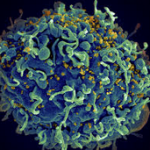 Compared to 20 years ago, HIV/AIDS is rarely in the news. And when it does appear, it is invariably more of the same good news. And that's on top of years of other good news.
Compared to 20 years ago, HIV/AIDS is rarely in the news. And when it does appear, it is invariably more of the same good news. And that's on top of years of other good news.
I recently wrote about Cuba becoming the first country to eliminate transmission of HIV from pregnant mothers to their unborn children, by using Truvada, the most commonly used HIV medicine used worldwide.
Additionally, I wrote about how AIDS drugs are so good that they were used to actually keep HIV-negative gay men infection-free simply by having them take the drugs prophylactically. During a two-year trial of gay men in San Francisco, zero percent of the 673 men studied became infected, despite a decrease in condom use. Zero percent.
And now we're writing about a small, but significant, advance in the HIV wars.
Tenofovir disoproxil fumarate (TDF) is one of the two drugs that make up Truvada, as well as other combination therapies. It works very well, but it has a downside: Long-term use essentially everyone who is taking the drug is associated with some kidney and bone toxicity.
But now, as reported in Medpage Today, tenofovir alafenamide (TAF), a drug that is a slightly modified version of TDF, has a superior safety profile.
TAF has yet to be approved, but it would seem to be a slam dunk. And physicians who treat HIV+ patients are very anxious for this to happen because of the potential for improved safety.
One of them is Dr. Karen Tashima, from the Alpert Medical School at Brown University in Providence, RI.
"We've been concerned about the long-term toxicity of TDF," she said. "We're excited to use the new TAF formulation of tenofovir."
Clinical results bear this out. In a 48-week study, as expected, both drugs were equally effective (97 percent), but TAF clearly demonstrated safety advances. The following is taken verbatim from the Medpage report:
- Serum creatinine [a measure of kidney function] decreased significantly, starting at week two of the new regimen.
- All markers of proteinuria [protein in the urine another measure of kidney function] fell significantly with TAF, while rising with TDF.
- Bone mineral density both at the hip and spine rose significantly, compared with patients remaining on TDF.
After 33 years of HIV/AIDS research with the first 14 years producing not a single drug to be able to tweak an already-great drug to make it even better is a good indication of the incredible progress that's been made in this area.
Many scientists consider this to be one of the most important and remarkable achievements in the history of drug discovery.
I am one of them.



